Expository Essay Writing is a genre of essay that tends to explain, illustrate, clarify, or explicate something with a neutral viewpoint so that it becomes apparent to the readers.
The word expository is derived from exposition, which is a noun of exposing. Expose means to lay or uncover something bare so that others understand what it is exactly. Thus, it can be an investigation, an evaluation, or argument about an idea, topic, or process.
Such essays are usually short assignments intended to test a writer’s composition skills or understanding of a given topic or subject. They usually involve less research and original arguments than argumentative essays. Nevertheless, it is essential to know that the genre of the writing may not always be directly stated in the assignment. Thus, writers should always look out for specific keywords, which implies that expository writing is required.
These include:
- Explain
- Define
- Explore
Types of Expository Essays
There are six different types and each type has a unique objective. The essays are all similar, but each type serves a different purpose.
They are discussed as follows:
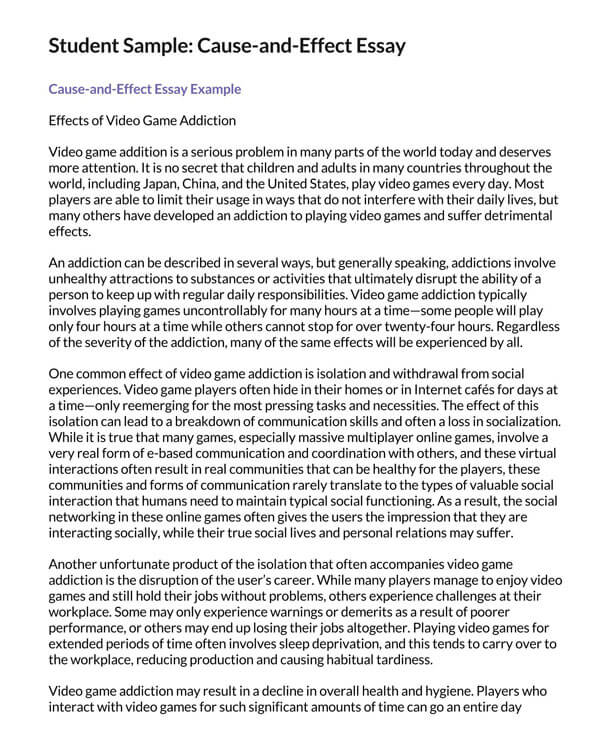
Cause and Effect Essay Example
Download: Microsoft Word (.docx)
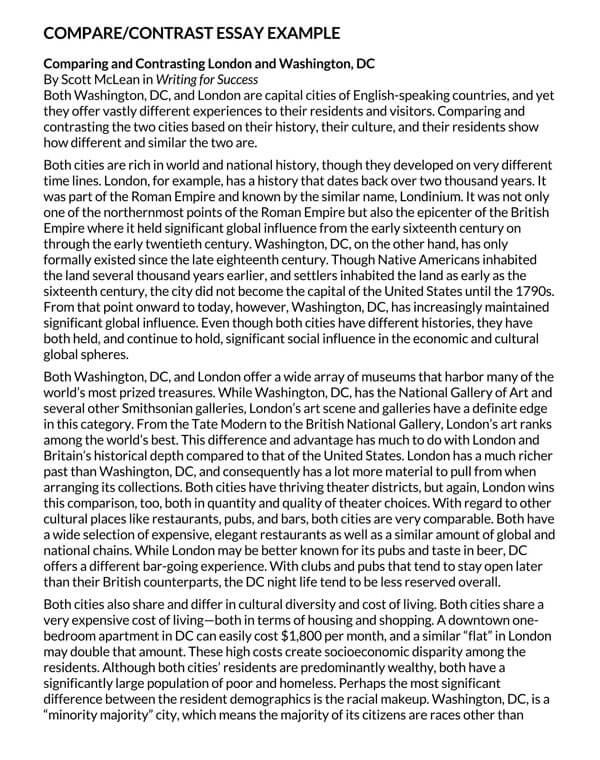
Compare and Contrast Essay Example
Download: Microsoft Word (.docx)
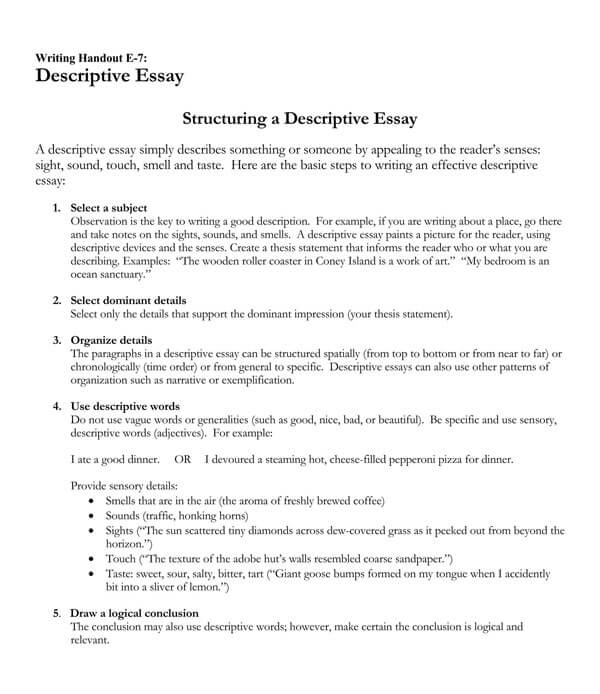
Descriptive Essay Example
Download: Microsoft Word (.docx)
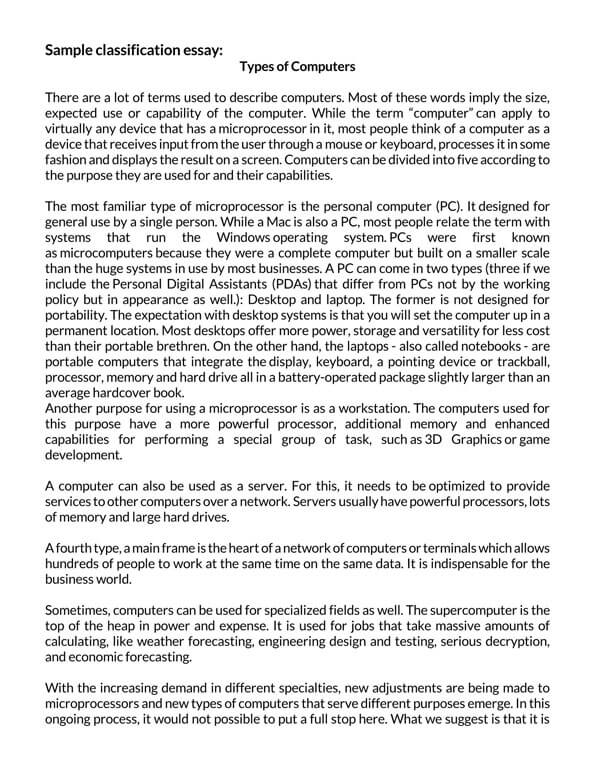
Classification Essay Example
Download: Microsoft Word (.docx)
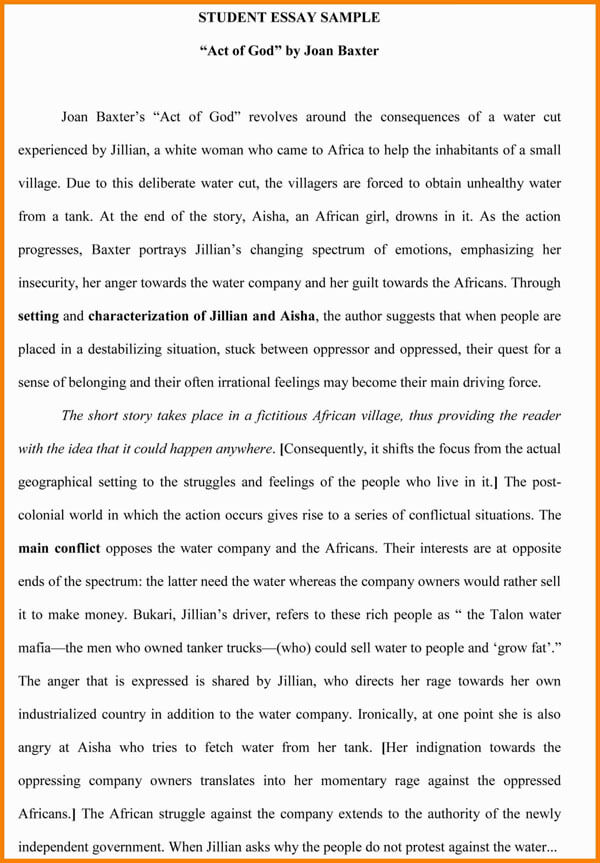
Process Essay Example
Download: Microsoft Word (.docx)
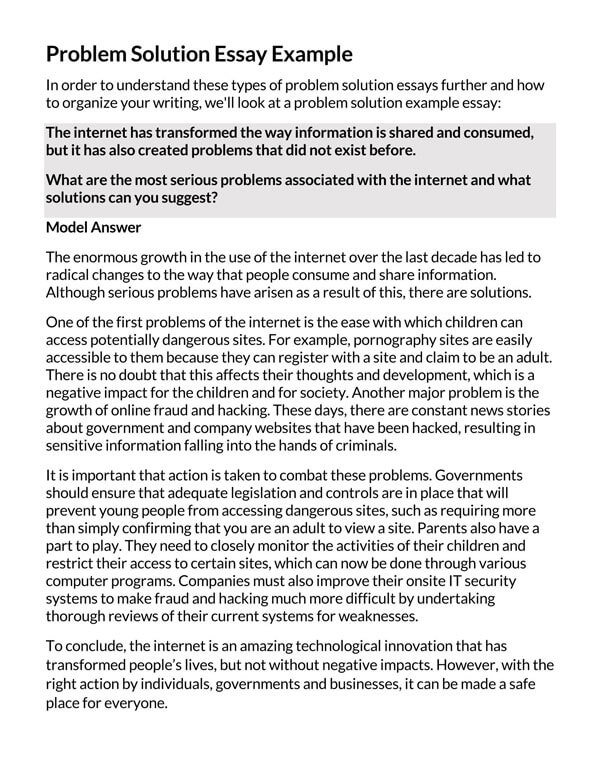
Problem and Solution Essay Example
Download: Microsoft Word (.docx)
Purpose of an Expository Essay
The primary purpose of writing this type of essay is to describe or explain something in a balanced and objective manner. The explanation can take various forms, some of which add audiovisual dimensions to the essay. When writing an essay, writers must provide a clear and logical explanation of complex information without proving their opinion on the given topic.
It can be written using various methods. However, all expository writings follow the same basic steps.
One effective method to consider when writing the essay is known as the POET method.
P- purpose
All such essays have a purpose, and writers must maintain consistency throughout their essays. To achieve this, writers should be attentive to the prompt’s verbs such as analyze, connect, compare, etc.
O- organization
It should be organized into three main sections. An appealing introductory paragraph, body paragraphs, and conclusion that summarizes all the points discussed in the essay’s body and how this ties back to the thesis statement.
E- evidence
Expository writings should not just present claims. Instead, it should present an idea that is backed up by evidence from reputable external links.
T- thesis
It should have a thesis statement that previews the writer’s thoughts on the given topic and how they plan to solidify their specific claims. The thesis statement forms the main idea of the essay, and each point and supporting evidence in the essay’s body should tie back to the thesis statement.
Characteristics of an Expository Essay
There are a few primary characteristics that it is usually based on. Generally, it has the following characteristics:
It is descriptive
One prominent feature of expository writing is that it is descriptive. The writing usually includes a background description of a particular topic, subject, or set of ideas so that the readers understand it well. The description is mainly written chronologically or hierarchically.
Illustrative
It should include a relevant illustration of a topic or process, and explicit references should support the theoretical points.
Explanatory
It is written to explain something to another person. Therefore, the writer’s pertinent theory should be provided to teach the reader about the given topic. This includes evaluating reasons and supporting the argument with relevant information from external sources.
Analytical
This is an imperative feature of expository writing as, through this process, the given subject, process, or idea is broken down into parts for categorization.
Impersonal
The use of first-person pronouns such as I and you are prohibited in expository writings. However, third-person pronouns are usually encouraged with this type of writing, and the language used should be formal.
Unbiased
The essay takes an objective approach meaning that the idea will be presented in an informative and balanced way. Therefore, the information provided does not state the author’s opinion.
They provide clarity
Clarity is usually the most crucial aspect of writing it. The author’s ideas or thoughts should be mentioned in the essay, and all arguments and supporting evidence must always tie back to the driving idea.
Expository Essay Example
Examples are intended to assist writers and students and guide them to write effective essays. First, they serve as a reference point. Second, they inspire the writers and provide valuable insights into how to structure the essay, the core parts to include, and the appropriate language and tone to use, and they are a source of inspiration.
Following is an example of such an essay:
Why online marketing is important
Over the last years, recent advancements of the world wide web have ultimately led to significant shifts in the advertising landscape. Online advertising has rapidly evolved with time, and nearly half of the world’s population uses the internet as a form of advertising for three main reasons.
First, most company’s target market audiences-people of all age groups are connected to the web. On the other hand, online marketing is mainly done to expand a business on a large scale. Second, the internet is the most inexpensive form of marketing that can allow a company to reach a broader target audience.
Secondly, online marketing is all-inclusive, affordable, and easy to handle. Therefore, it provides multiple opportunities for both large-scale and small-scale farmers to enhance their sales productively.
Thirdly, there are no limits to who can venture into online marketing or advertising and adopt it as a strategy to boost online presence and achieve their advertising goals. Thus, online marketing is the present, the future, and an important part of businesses to survive.
In conclusion, online marketing is crucial for the success of any business in the contemporary dynamic society, as most people are now increasingly using the internet to seek information about products and their prices before making any purchases. This means that every entrepreneur and marketer should use this modern-age advertising tool to enhance their client base, generate leads, reach their market goals, and ultimately help increase their profits.
Benefits of an Expository Essay
Mastering the art of writing it is beneficial to writers in that it allows you to develop some valuable skills. Its benefits to writers include:
- Research and evaluation skills: These essays are usually about research, and frequently writing these essays allows a writer to develop excellent research and evaluation skills.
- Articulacy in their writings: The clear and concise style of writing these essays allows writers to present information unambiguously and straightforwardly.
- Time management and organizational skills: In expository writing, writers are required to organize and present thoughts or ideas chronologically or hierarchically. This is essential in developing a writer’s time management and organizational skills, ideal in everyday life.
- Ability to think critically: Such essays are often associated with the assessment of an issue and describing it based on different perspectives. This enables the writer to develop their critical thinking capabilities.
Structure of an Expository Essay
It has a particular structure that contributes to its properness and credibility. Its structure includes the following key points:
- A strong, concise, and defined thesis statement in the first paragraph that follows the guidelines outlined in the main topic of discussion.
- Each body paragraph should be connected with at least 1-2 sentences that demonstrate how each idea leads into the next and how they work together to support the writer’s position. This enables the reader to follow and understand the essay’s argument.
- Evidential support in body paragraphs in the form of facts, statistics, or anecdotes should be provided to allow for clarity and direction throughout the essay. However, this type of writing does not always allow for a great deal of statistical or factual evidence.
- Pinch of creativity and artfulness are not commonly associated with essay writing, but descriptive essay writers should add a bit of creativity to make their work enjoyable and leave a lasting impression on the readers.
- Its concluding paragraph should not restate the essay’s thesis but rather readdress each paragraph’s evidential support. This leaves an immediate and lasting impression on the reader’s mind.
Main Parts of an Expository Essay
The structure of expository writing can vary depending on the scope and demands of a particular topic. However, regardless of its purpose, it should have at least five sections: the introductory section, first body paragraph, second body paragraph, third body paragraph, and a conclusion.
Each section discusses different things that all tie up to the main idea of the essay:
Introduction
Like any other essay, it must begin with an introductory paragraph. This paragraph serves as an attention grabber for the readers. Therefore, the writer should begin by briefly introducing their essay’s topic and providing a thesis statement that summarizes what they will say in the rest of the paper. The thesis statement should be clear, concise, and defined to avoid repeating what will be covered in the rest of the essay.
Body paragraphs
The first body paragraph of this essay should focus on one of the writer’s main points and provide evidence supporting the point. Skillful writers will typically provide two-three supporting points- reasons, facts, quotations, statistics, examples, or a mix of both.
Both the second and third body paragraphs should follow the same pattern- each with a point that supports the thesis statement, to provide the reader with enough detail to be convinced of the writer’s arguments and fully understand the concept being discussed or explained. However, it is vital to understand that some sections may require further explanations, thus separating the information into multiple paragraphs.
It is recommended that writers organize their body paragraphs logically with clear transitions to explain their ideas. For instance, if a writer describes a process, they may use the chronological format to demonstrate the definite time sequence in which the steps need to happen.
Conclusion
The essay’s concluding paragraph provides a concise summary of the body paragraphs, but writers should be careful not to restate what has already been written. Instead, to write an effective conclusion, look back at the main idea of each paragraph and try to summarize the point or thoughts using words that are different from those that have been used within the paragraphs. However, refrain from introducing or including new points in the concluding paragraph.
tip
Always ensure to conclude your essay in a reader-engaging way, stay clear and be very objective in presenting your thoughts, ideas, or points.
Process of Writing an Expository Essay
For most careers, expository writing is an essential daily requirement. Understanding and mastering the process of writing an essay can benefit writers, including students.
Here is the practical process of writing it:
Prewriting/outline
In this phase, writers should take some time brainstorming the topic and its main idea. Next, do extensive research, take notes, then create an outline of the information in each paragraph, and organize the points logically.
Drafting phase
In the initial drafting phase, writers should consider the following valuable tips:
- Write the topic sentence in the introductory paragraph, stating the thesis or central idea of the essay. The thesis should be clearly stated, and it should be objective and neutral.
- The three body paragraphs should each cover a different point that develops the essay’s thesis, and evidence should be provided to validate the points.
- The conclusion should reinforce the thesis and the main supporting ideas, and new facts or points should not be introduced in the conclusion.
- The essay should be drafted in third person pronouns and avoid the use of I or you pronouns. This is because expository essays discuss an event, situation, or the views of others and not a personal experience.
Revising
In this phase, writers are advised to review, modify, and reorganize their writing to achieve the best version.
The writer should ensure that:
- The essay provides an unbiased analysis that unfolds logically using relevant supporting evidence
- It has information that clearly and effectively communicates to the reader
- It is focused on the main topic of discussion and does not include unnecessary details.
Editing
The last step involves proofreading to correct any errors in grammar and mechanism and edit to improve the essay’s style and clarity. In this phase, writers are also encouraged to ask their friends to review the document and offer feedback. This helps the writer to edit the work with a fresh perspective, making it even better.
Tips for Writing an Expository Essay
These essays tend to be investigative, which means that the writer must analyze a given topic and report the facts, regardless of their opinion on the subject.
To write an effective essay, consider the following helpful tips:
- Think of an appealing topic or headline for the essay, but make sure it ties back to the thesis statement.
- Choose an appropriate essay structure that includes the main parts of the essay.
- Before writing, scribble down a brief outline of what will be discussed in the essay, starting with a one-line summary of the main idea, followed by three main points and relevant supporting evidence. Remember first to conduct thorough research to have a better understanding of the topic.
- Verify the point of view and write in an objective third-person point of view. For example, if the essay describes a process or an activity, second-person pronouns may be acceptable.
- Use clear and concise language and avoid presenting any biased information. Refrain from using any figurative language that readers may not be able to understand.
- Organize the points and facts logically to make it easier for the readers to follow and understand the concepts and arguments. Moreover, sentences of different lengths and appropriate transitions to achieve better rhythm and separate paragraphs, respectively.
- While including any supporting evidence in the body paragraphs, use reputable sources as reference points.
- Proofread the work to check for any grammar and spelling mistakes and edit the essay accordingly.
Frequently Asked Questions
Generally, it should be between 500 and 800 words long.
It can be written anytime a writer or student is asked to investigate or explain something.
Typical expository writing format includes an introduction, body paragraphs subdivided into the first body paragraph, second body paragraph, third body paragraph, and conclusion.










